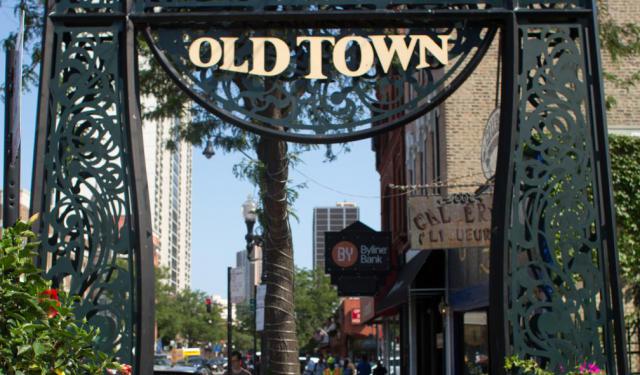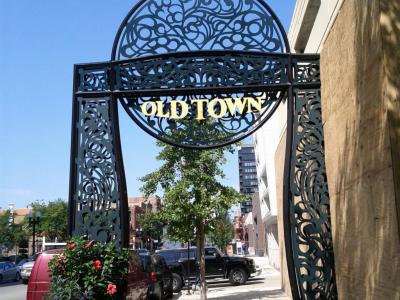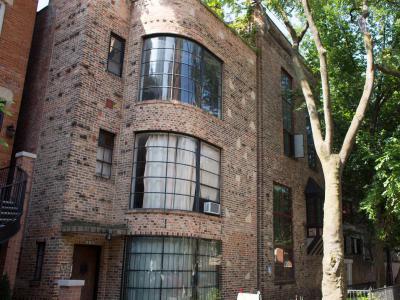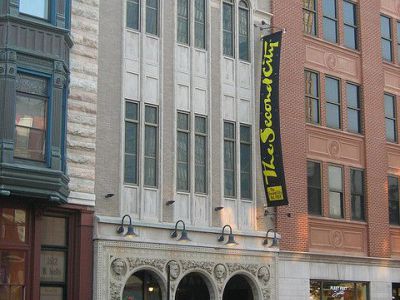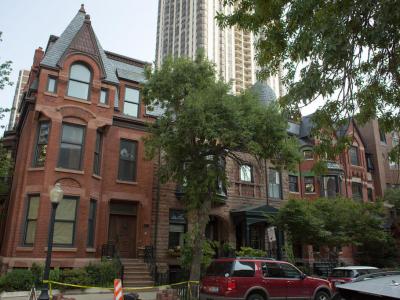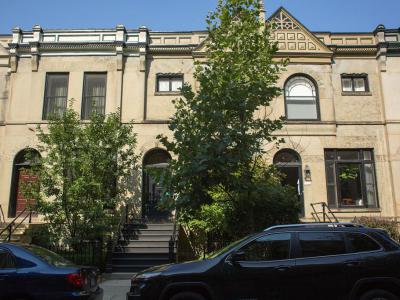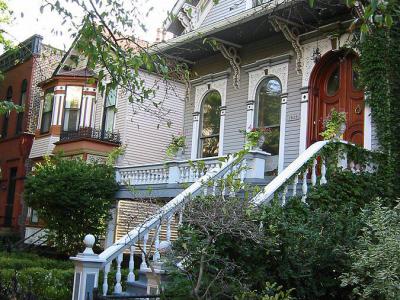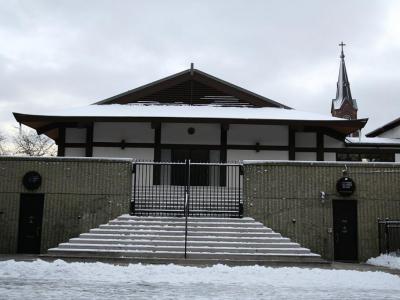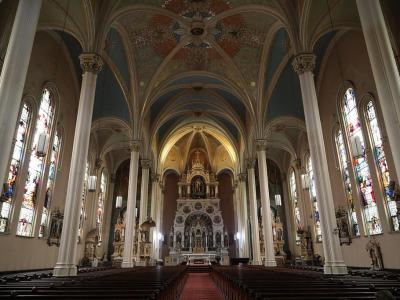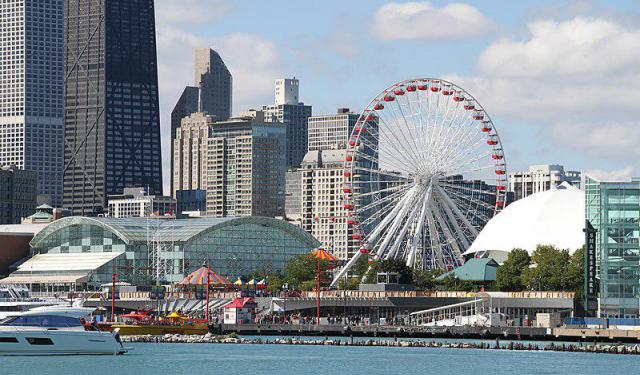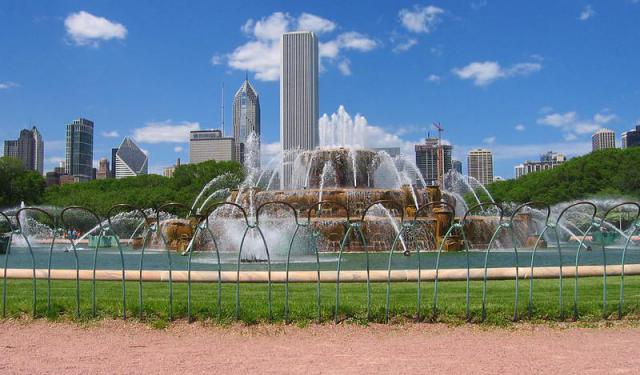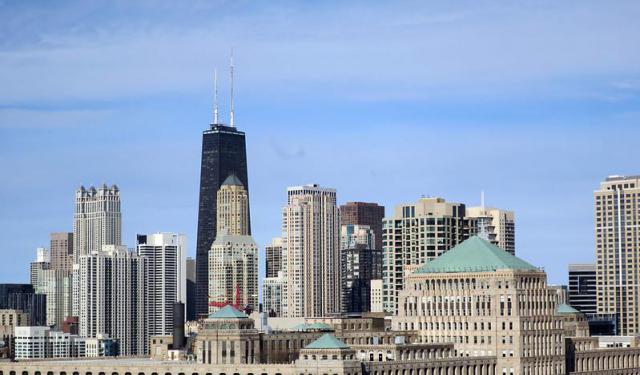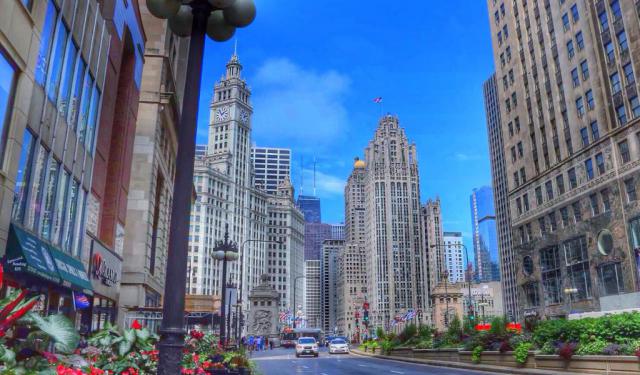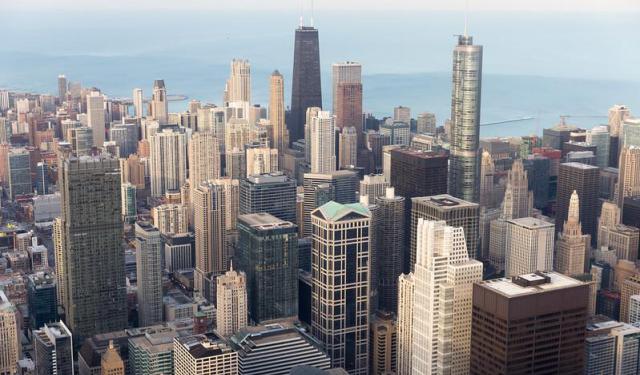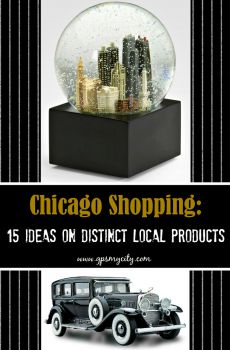Chicago Old Town Walking Tour (Self Guided), Chicago
Settled in 1850 by German immigrants, Chicago’s Old Town neighborhood is a popular destination for locals and visitors who cater to the entertainment venues, restaurants, pubs, coffee shops and boutiques – all of which have turned an area once referred to as the “Cabbage Patch” into an attraction that rivals Navy Pier, Wrigley Field and the Magnificent Mile.
Start your Old Town walking tour with a stroll down Wells Street for dining and entertainment, then make a turn towards the architecturally and culturally significant West Burton Place to see how artists and craftspeople of the Depression Era transformed what were then deteriorating 19th-century rooming houses into a series of unique and cohesive artist studio environments.
Next up is the excellent Chicago History Museum’s coverage of all aspects of the city’s history, starting with a model of a fort and expanding into modern territory (including insights into Chicago’s leading role in innovations and design), while right opposite stands the Second City Theatre – a place that launched the career of many great comics, and that remains rooted in improvisational games you can experience today.
Further along the way, don’t miss a visit to St. Michael’s Church and the close-by Midwest Buddhist Temple (a fixture in Old Town since 1944), both located in beautiful green and quiet surroundings.
Take a self-guided walk through this clean and safe neighborhood to fully understand Chicago as a city!
Start your Old Town walking tour with a stroll down Wells Street for dining and entertainment, then make a turn towards the architecturally and culturally significant West Burton Place to see how artists and craftspeople of the Depression Era transformed what were then deteriorating 19th-century rooming houses into a series of unique and cohesive artist studio environments.
Next up is the excellent Chicago History Museum’s coverage of all aspects of the city’s history, starting with a model of a fort and expanding into modern territory (including insights into Chicago’s leading role in innovations and design), while right opposite stands the Second City Theatre – a place that launched the career of many great comics, and that remains rooted in improvisational games you can experience today.
Further along the way, don’t miss a visit to St. Michael’s Church and the close-by Midwest Buddhist Temple (a fixture in Old Town since 1944), both located in beautiful green and quiet surroundings.
Take a self-guided walk through this clean and safe neighborhood to fully understand Chicago as a city!
How it works: Download the app "GPSmyCity: Walks in 1K+ Cities" from Apple App Store or Google Play Store to your mobile phone or tablet. The app turns your mobile device into a personal tour guide and its built-in GPS navigation functions guide you from one tour stop to next. The app works offline, so no data plan is needed when traveling abroad.
Chicago Old Town Walking Tour Map
Guide Name: Chicago Old Town Walking Tour
Guide Location: USA » Chicago (See other walking tours in Chicago)
Guide Type: Self-guided Walking Tour (Sightseeing)
# of Attractions: 9
Tour Duration: 2 Hour(s)
Travel Distance: 2.6 Km or 1.6 Miles
Author: doris
Sight(s) Featured in This Guide:
Guide Location: USA » Chicago (See other walking tours in Chicago)
Guide Type: Self-guided Walking Tour (Sightseeing)
# of Attractions: 9
Tour Duration: 2 Hour(s)
Travel Distance: 2.6 Km or 1.6 Miles
Author: doris
Sight(s) Featured in This Guide:
- Wells Street
- West Burton Place Historic District
- Chicago History Museum
- Second City Theater
- Olsen-Hansen Row Houses
- Crilly Court
- Menomonee Street
- Midwest Buddhist Temple Taiko
- St. Michael's Church
1) Wells Street
Wells Street is the main drag of Chicago's charming Old Town, whose epicenter sits at the crossroads of Wells Street and North Avenue. On the southeast corner, extending gracefully from this juncture, lies a fine neighborhood of time-honored townhouses (late 1800s to early 1900s) lined along three streets: Dearborn, State, and Astor.
Wells Street boasts an array of dependable dining establishments and watering holes, but the ambiance here is decidedly more laid-back, with prices that won't send your wallet into a tailspin, unlike the posh locales of River North or the Magnificent Mile. If you're in the mood for brunch, NOOKIES is the undisputed champion, drawing a loyal crowd of locals who bask in the embrace of its exceedingly affable staff. The menu offers an array of breakfast, lunch, and dinner options, and the portions are so generous that they provide takeout containers for your impending leftovers. When the sun graces Chicago with its presence, there's even a smattering of outdoor seating.
For those seeking an authentic Irish pub experience (because who wouldn't want one in Chicago?), the perfectly situated DECLAN'S is a must, purporting to be the official bar of the University of Notre Dame. Meanwhile, the OLD TOWN PUB offers not only reasonable prices but also surprisingly delightful fare and libations. Step inside, and you'll discover a subtle charm that permeates its interior.
Tip:
Mark your calendar for the second weekend in June when the Old Town Art Fair and the Wells Street Art Festival set the neighborhood ablaze with creativity. These events showcase the remarkable work of local artists, complete with a live music stage, food vendors, and children's theater, unfolding between North Avenue and Division Street, from 10 AM to 10 PM daily.
Wells Street boasts an array of dependable dining establishments and watering holes, but the ambiance here is decidedly more laid-back, with prices that won't send your wallet into a tailspin, unlike the posh locales of River North or the Magnificent Mile. If you're in the mood for brunch, NOOKIES is the undisputed champion, drawing a loyal crowd of locals who bask in the embrace of its exceedingly affable staff. The menu offers an array of breakfast, lunch, and dinner options, and the portions are so generous that they provide takeout containers for your impending leftovers. When the sun graces Chicago with its presence, there's even a smattering of outdoor seating.
For those seeking an authentic Irish pub experience (because who wouldn't want one in Chicago?), the perfectly situated DECLAN'S is a must, purporting to be the official bar of the University of Notre Dame. Meanwhile, the OLD TOWN PUB offers not only reasonable prices but also surprisingly delightful fare and libations. Step inside, and you'll discover a subtle charm that permeates its interior.
Tip:
Mark your calendar for the second weekend in June when the Old Town Art Fair and the Wells Street Art Festival set the neighborhood ablaze with creativity. These events showcase the remarkable work of local artists, complete with a live music stage, food vendors, and children's theater, unfolding between North Avenue and Division Street, from 10 AM to 10 PM daily.
2) West Burton Place Historic District
Just a hop and a skip away from the rigorously planned Carl Sandburg Village lies a charmingly chaotic realm that can only be described as Old Town's artistic birthplace. It all began in 1927 when a lively congregation of artists and craftsmen decided to breathe new life into the streets of West Burton Place.
Their canvas primarily consisted of Victorian houses, like the still-standing #147 and #164–166 (both dating back to 1881), which they transformed with an exuberant and freewheeling artistic flair. Some houses received a mere touch-up, while others were enveloped in brick, adorned with new wings, and molded into entirely new forms. These visionaries, though short on funds, possessed an abundance of imagination. They scoured Maxwell Street flea markets in search of tiles, copper bathtubs, wooden doors, and assorted hardware to bring their visions to life. Construction was a slow, apartment-by-apartment process, with rental income funneling into these painstaking unit conversions. Some dwellings were never truly finished, as their owners continued to infuse them with new artistic creations. Grateful tenants and homeowners alike have since preserved and further embellished these structures. In 2016, architect P. K. VanderBeke successfully advocated for and obtained city landmark status for the entire block.
Among the treasures on this artistic avenue is Theophil Studios, located at #143. Here, artist Theophil Reuther transformed a 1892 house into a Modern masterpiece with stucco facades adorned by red-brick accents, porthole windows, and decorative plaques. The real highlight, however, is the sprawling Carl Street Studios at #155. Loosely inspired by the Montmartre studios in Paris, this labyrinthine creation is the brainchild of the versatile Art Deco artist and craftsman, Edgar Miller. Behind its whimsical brick wall, you'll discover a maze of tile-studded sidewalks, intricately carved wooden doors and staircases, narrow winding passages, stained glass windows, and a pair of charming courtyard gardens complete with serene koi ponds!
Their canvas primarily consisted of Victorian houses, like the still-standing #147 and #164–166 (both dating back to 1881), which they transformed with an exuberant and freewheeling artistic flair. Some houses received a mere touch-up, while others were enveloped in brick, adorned with new wings, and molded into entirely new forms. These visionaries, though short on funds, possessed an abundance of imagination. They scoured Maxwell Street flea markets in search of tiles, copper bathtubs, wooden doors, and assorted hardware to bring their visions to life. Construction was a slow, apartment-by-apartment process, with rental income funneling into these painstaking unit conversions. Some dwellings were never truly finished, as their owners continued to infuse them with new artistic creations. Grateful tenants and homeowners alike have since preserved and further embellished these structures. In 2016, architect P. K. VanderBeke successfully advocated for and obtained city landmark status for the entire block.
Among the treasures on this artistic avenue is Theophil Studios, located at #143. Here, artist Theophil Reuther transformed a 1892 house into a Modern masterpiece with stucco facades adorned by red-brick accents, porthole windows, and decorative plaques. The real highlight, however, is the sprawling Carl Street Studios at #155. Loosely inspired by the Montmartre studios in Paris, this labyrinthine creation is the brainchild of the versatile Art Deco artist and craftsman, Edgar Miller. Behind its whimsical brick wall, you'll discover a maze of tile-studded sidewalks, intricately carved wooden doors and staircases, narrow winding passages, stained glass windows, and a pair of charming courtyard gardens complete with serene koi ponds!
3) Chicago History Museum (must see)
Set on a picturesque piece of land near the Lincoln Park Zoo and the lakefront, this institution traces Chicago's rich and often complicated history, starting with its first explorers and settlers, through the city's development, to major events in modern-day Chicago. Inside, you'll find a harmonious blend of vintage and contemporary elements, with everything kept pristinely clean and tidy. It's an easy-in/easy-out museum, great to wander about for a couple of hours without the jostling crowds.
What many might not realize is that the CHM houses one of the nation's largest collections of costumes and textiles, a staggering 50,000 pieces spanning from the 18th century to the present day. It also boasts an astonishing trove of artifacts and original artworks that are not only significant to Chicago's history but also integral to the broader context of U.S. history. These include the very bed in which Abraham Lincoln took his final breath, haunting reminders of Civil War-era slave shackles, original paintings by the iconic Norman Rockwell, a restored turn-of-the-century train car and other fascinating curiosities. For sports fans, a special treat is the display honoring Chicago's legendary athletes, from Ernie Banks and Michael Jordan to Dick Butkus, Mike Ditka, Bobby Hull, and Stan Mikita.
Among permanent exhibitions, "Chicago: Crossroads of America" stands out as a celebration of the city's cultural contributions, from the birth of urban blues to the triumphs of skyscraper architecture, and sheds light on significant events like the Haymarket Affair, unraveling the complexities of an 1884 labor rally where a bomb altered the course of history and led to the conviction of eight anarchists for conspiracy. In "Sensing Chicago", young visitors can step back in time to experience the city's bygone era by catching a fly ball at Comiskey Park, donning costumes inspired by Chicago-style hot dogs, and taking a spin on a penny-farthing bicycle. "City on Fire: Chicago 1871" plunges visitors into the chaos and aftermath of the infamous inferno that displaced one-third of its population in a mere two days.
What many might not realize is that the CHM houses one of the nation's largest collections of costumes and textiles, a staggering 50,000 pieces spanning from the 18th century to the present day. It also boasts an astonishing trove of artifacts and original artworks that are not only significant to Chicago's history but also integral to the broader context of U.S. history. These include the very bed in which Abraham Lincoln took his final breath, haunting reminders of Civil War-era slave shackles, original paintings by the iconic Norman Rockwell, a restored turn-of-the-century train car and other fascinating curiosities. For sports fans, a special treat is the display honoring Chicago's legendary athletes, from Ernie Banks and Michael Jordan to Dick Butkus, Mike Ditka, Bobby Hull, and Stan Mikita.
Among permanent exhibitions, "Chicago: Crossroads of America" stands out as a celebration of the city's cultural contributions, from the birth of urban blues to the triumphs of skyscraper architecture, and sheds light on significant events like the Haymarket Affair, unraveling the complexities of an 1884 labor rally where a bomb altered the course of history and led to the conviction of eight anarchists for conspiracy. In "Sensing Chicago", young visitors can step back in time to experience the city's bygone era by catching a fly ball at Comiskey Park, donning costumes inspired by Chicago-style hot dogs, and taking a spin on a penny-farthing bicycle. "City on Fire: Chicago 1871" plunges visitors into the chaos and aftermath of the infamous inferno that displaced one-third of its population in a mere two days.
4) Second City Theater (must see)
The crown jewel of Old Town's entertainment scene, this comedy club is known for first-class acts who ascended to stardom on the silver screen. The names of comedy titans like Mike Myers, Bill Murray, John Belushi, and Tina Fey grace its "Foyer of Fame."
A hub of cultural relevance and uproarious humor, the place consistently draws crowds, creating an electric atmosphere, though visitors should come prepared for a healthy dose of colorful language and progressive political commentary. Portions of the performances involve interactive improvisation with the audience; in fact, the grand finale, occurring around 10:30pm, is just that, and no ticket is required to attend as the cast tries out new comedic material. Seats are otherwise considered first-come, first-served, so be sure to arrive 20-30 minutes early if you want the full experience or opt to secure reserved seats along the rail for an added fee.
It's worth noting that beyond the Second City Theater, this complex houses a Sony Multiplex cinema, as well as a variety of restaurants and even a Starbucks. The theater's mainstage entrance features elegant stone arches adorned with faces originally from the Adler and Sullivan-designed Garrick Theater.
Tip:
For a glimpse into Old Town's beatnik history, venture to the time-honored OLD TOWN ALE HOUSE (Sun-Fri: 3pm–4am; Sat: 3pm–5am), famed for its proximity to Second City and the cast's penchant for hanging out there after performances. With its vintage decor and a lending library, the place oozes character from every nook and cranny. It's a lively spot, particularly on weekends, where the vivacity adds to the fun. Don't forget to check the mural behind the bar, paying a tribute to Second City legends like John Belushi and Bill Murray.
A hub of cultural relevance and uproarious humor, the place consistently draws crowds, creating an electric atmosphere, though visitors should come prepared for a healthy dose of colorful language and progressive political commentary. Portions of the performances involve interactive improvisation with the audience; in fact, the grand finale, occurring around 10:30pm, is just that, and no ticket is required to attend as the cast tries out new comedic material. Seats are otherwise considered first-come, first-served, so be sure to arrive 20-30 minutes early if you want the full experience or opt to secure reserved seats along the rail for an added fee.
It's worth noting that beyond the Second City Theater, this complex houses a Sony Multiplex cinema, as well as a variety of restaurants and even a Starbucks. The theater's mainstage entrance features elegant stone arches adorned with faces originally from the Adler and Sullivan-designed Garrick Theater.
Tip:
For a glimpse into Old Town's beatnik history, venture to the time-honored OLD TOWN ALE HOUSE (Sun-Fri: 3pm–4am; Sat: 3pm–5am), famed for its proximity to Second City and the cast's penchant for hanging out there after performances. With its vintage decor and a lending library, the place oozes character from every nook and cranny. It's a lively spot, particularly on weekends, where the vivacity adds to the fun. Don't forget to check the mural behind the bar, paying a tribute to Second City legends like John Belushi and Bill Murray.
5) Olsen-Hansen Row Houses (must see)
Most prominently employed in residential architecture, the Queen Anne style left an indelible mark on Chicago during the latter half of the 19th century. In this city, much like other American urban centers, the term "Queen Anne" doesn't denote a specific historical epoch or a rigidly defined architectural template; instead, it seamlessly blends architectural elements drawn from Classical, Tudor, Victorian, and Colonial influences to create a distinctive and eclectic look.
The Queen Anne style finds exquisite expression in Chicago's architectural landscape, with noteworthy examples like Crilly Court (constructed in 1885) and the ornate Olsen-Hansen Row Houses (completed in 1886) on West Eugenie Street. While only five of the original twelve houses from the latter project still grace the neighborhood (with No. 164 having served as the residence of the Norwegian-born architect Hansen himself), they collectively serve as splendid exemplars of the aesthetic. These homes showcase the hallmark features of the era, including distinctive turrets, an array of window designs, irregular rooflines, elaborate Victorian porches, and a harmonious medley of diverse building materials and colors, epitomizing the exuberance of architectural design during that period.
The Queen Anne style finds exquisite expression in Chicago's architectural landscape, with noteworthy examples like Crilly Court (constructed in 1885) and the ornate Olsen-Hansen Row Houses (completed in 1886) on West Eugenie Street. While only five of the original twelve houses from the latter project still grace the neighborhood (with No. 164 having served as the residence of the Norwegian-born architect Hansen himself), they collectively serve as splendid exemplars of the aesthetic. These homes showcase the hallmark features of the era, including distinctive turrets, an array of window designs, irregular rooflines, elaborate Victorian porches, and a harmonious medley of diverse building materials and colors, epitomizing the exuberance of architectural design during that period.
6) Crilly Court
Constructed in 1885 under the visionary guidance of real-estate developer Daniel Crilly, the row houses of Crilly Court emerge as a quintessential embodiment of the Queen Anne architectural style in Chicago. With their elegant turrets and bay windows, these residences have bestowed upon the city one of its most picturesque streets.
Lining the west side of the court are two-story stone row houses, while on the opposite flank stands an imposing four-story apartment building. Above the entrances, one can spot the carved names of Daniel Crilly's four children – Isabelle, Edgar, Oliver, and Erminnie.
In the 1940s, a comprehensive renovation initiative breathed new life into this development. Private courtyards were crafted, and wrought-iron balconies were installed, imparting an ambiance reminiscent of the charm found in New Orleans. This transformation not only revitalized the complex but also catalyzed the broader Lincoln Park neighborhood's renewal shortly thereafter.
Lining the west side of the court are two-story stone row houses, while on the opposite flank stands an imposing four-story apartment building. Above the entrances, one can spot the carved names of Daniel Crilly's four children – Isabelle, Edgar, Oliver, and Erminnie.
In the 1940s, a comprehensive renovation initiative breathed new life into this development. Private courtyards were crafted, and wrought-iron balconies were installed, imparting an ambiance reminiscent of the charm found in New Orleans. This transformation not only revitalized the complex but also catalyzed the broader Lincoln Park neighborhood's renewal shortly thereafter.
7) Menomonee Street
Nestled within the heart of the Triangle Historic District, Menomonee Street meanders through a delightful neighborhood characterized by slender, tree-lined avenues, picturesque residences, and quite a few interesting shops and eateries.
Taking a stroll along this quaint street offers a captivating glimpse into the architectural essence of the Old Town community before the Great Chicago Fire of 1871. Most of the original dwellings in the area were small cottages with lightweight wooden frames that succumbed to the flames; however, the community's resilient spirit is showcased by the homes at Nos. 325–45, faithfully rebuilt in the same style and using the same materials that defined their predecessors.
Of particular historical significance are the pale gray abodes at Nos. 348 and 216, situated on the street's periphery, representing rare surviving examples of the one-room "fire relief" shanties, built to shelter the fire-ravaged homeless population. The city invested about $100 in each of these structures, which were transported on wagons to vacant lots, providing immediate respite for those in need.
Tip:
A venture eastward towards Sedgwick Street will lead you to one of Chicago's most venerable taverns – MARGE'S STILL (Tue-Fri: 4:30pm–12am; Sat: 4pm–1am; Sun: 12–8pm). From outside in and inside out, the place looks great; one you'll want to walk into and spend a lot of time in if you can. Great beer selection, too, and their "world-famous" pot pie is no joke, either!
Taking a stroll along this quaint street offers a captivating glimpse into the architectural essence of the Old Town community before the Great Chicago Fire of 1871. Most of the original dwellings in the area were small cottages with lightweight wooden frames that succumbed to the flames; however, the community's resilient spirit is showcased by the homes at Nos. 325–45, faithfully rebuilt in the same style and using the same materials that defined their predecessors.
Of particular historical significance are the pale gray abodes at Nos. 348 and 216, situated on the street's periphery, representing rare surviving examples of the one-room "fire relief" shanties, built to shelter the fire-ravaged homeless population. The city invested about $100 in each of these structures, which were transported on wagons to vacant lots, providing immediate respite for those in need.
Tip:
A venture eastward towards Sedgwick Street will lead you to one of Chicago's most venerable taverns – MARGE'S STILL (Tue-Fri: 4:30pm–12am; Sat: 4pm–1am; Sun: 12–8pm). From outside in and inside out, the place looks great; one you'll want to walk into and spend a lot of time in if you can. Great beer selection, too, and their "world-famous" pot pie is no joke, either!
8) Midwest Buddhist Temple Taiko
Buddhism varies quite a bit by nationality, sect, ethnicity, and geography. This particular temple adheres to the "Pure Land" sect, founded by Japanese-Americans fleeing the growing scapegoating racism of the American West during WWII. While the Midwest was comparatively more accepting, some of this sect's unique practices also facilitated their harmonious integration with minimal conflicts.
The temple is set up more like an American Protestant Church with Japanese architectural influence (primarily expressed in the combination gable and hip roof), rather than a traditional Japanese mainstream temple. Visitors here are encouraged to keep their shoes on and occupy Western-style pews, as opposed to traditional Japanese tatami mats. Sunday morning services are led by ministers rather than monks, and Dharma talks mimic homilies or sermons. Japanese is retained only in the opening chant during English services, and intriguingly, some of the hymns are adapted from Protestant traditional hymns with adjusted words.
A visit to this temple is particularly recommended for those with an interest in comparative religion, anthropology, immigration history, cross-cultural studies, as well as individuals associated with other Buddhist groups.
Tip:
Mark your calendar for the Ginza Holiday Festival, which takes place during the second week of August. This annual fundraiser features delicious Teriyaki chicken, a wide selection of goods for sale, and fantastic entertainment with the mesmerizing rhythms of Taiko drums.
The temple is set up more like an American Protestant Church with Japanese architectural influence (primarily expressed in the combination gable and hip roof), rather than a traditional Japanese mainstream temple. Visitors here are encouraged to keep their shoes on and occupy Western-style pews, as opposed to traditional Japanese tatami mats. Sunday morning services are led by ministers rather than monks, and Dharma talks mimic homilies or sermons. Japanese is retained only in the opening chant during English services, and intriguingly, some of the hymns are adapted from Protestant traditional hymns with adjusted words.
A visit to this temple is particularly recommended for those with an interest in comparative religion, anthropology, immigration history, cross-cultural studies, as well as individuals associated with other Buddhist groups.
Tip:
Mark your calendar for the Ginza Holiday Festival, which takes place during the second week of August. This annual fundraiser features delicious Teriyaki chicken, a wide selection of goods for sale, and fantastic entertainment with the mesmerizing rhythms of Taiko drums.
9) St. Michael's Church
By tradition, if the chimes of Saint Michael's bells reach your ears, you'll know you're in Old Town. Owing to its thick, redbrick walls, this 19th-century Romanesque monument, founded and maintained by German immigrants, was among the six select buildings that survived the path of the 1871 Great Chicago Fire. Although there is a small memorial dedicated to Catholic war veterans on its grounds, it has become a haven for the local Puerto Rican community.
The church is distinguished by a commanding bell tower adorned with a sizable four-faced clock and an ensemble of five bells, each weighing between 2,500 to 6,000 pounds (or 1.1 to 2.7 tons). Visitors have the opportunity to explore the beautiful Bavarian Baroque interior with tall, thin stained-glass windows crafted by the Mayer Window Institute of Munich, along with vivid frescoes and a carving depicting "The Last Supper" (acquired from the 1893 World's Columbian Exposition). A functional Kilgen pipe organ adds to the sensory richness of the space; however, the crowning jewel is the magnificent high altar, along with four subsidiary altars, portraying Saint Michael flanked by archangels Raphael and Gabriel, capturing the moment of Lucifer's expulsion from heaven.
The church is distinguished by a commanding bell tower adorned with a sizable four-faced clock and an ensemble of five bells, each weighing between 2,500 to 6,000 pounds (or 1.1 to 2.7 tons). Visitors have the opportunity to explore the beautiful Bavarian Baroque interior with tall, thin stained-glass windows crafted by the Mayer Window Institute of Munich, along with vivid frescoes and a carving depicting "The Last Supper" (acquired from the 1893 World's Columbian Exposition). A functional Kilgen pipe organ adds to the sensory richness of the space; however, the crowning jewel is the magnificent high altar, along with four subsidiary altars, portraying Saint Michael flanked by archangels Raphael and Gabriel, capturing the moment of Lucifer's expulsion from heaven.
Walking Tours in Chicago, Illinois
Create Your Own Walk in Chicago
Creating your own self-guided walk in Chicago is easy and fun. Choose the city attractions that you want to see and a walk route map will be created just for you. You can even set your hotel as the start point of the walk.
University of Chicago Walking Tour
Founded in 1890, the University of Chicago is among the world’s most prestigious educational institutions. As of 2020, the University’s students, faculty and staff have included 100 Nobel laureates, giving it the fourth-most affiliated Nobel laureates of any university.
Set in the heart of Chicago’s famous eclectic neighborhood, Hyde Park, the campus is worth a visit as it offers a... view more
Tour Duration: 2 Hour(s)
Travel Distance: 2.5 Km or 1.6 Miles
Set in the heart of Chicago’s famous eclectic neighborhood, Hyde Park, the campus is worth a visit as it offers a... view more
Tour Duration: 2 Hour(s)
Travel Distance: 2.5 Km or 1.6 Miles
Chicago Navy Pier Walking Tour
Additional to scenic views of the lake, the boats, and the city skyline, the Navy Pier offers a variety of attractions on the waterfront – for kids as well as adults – that draw nearly ten million people annually, making this Chicago's most visited spot. Yes, some may see it as a “tourist trap”, but it is worth the time and money to spend some time here, so take this self-guided walk... view more
Tour Duration: 1 Hour(s)
Travel Distance: 1.0 Km or 0.6 Miles
Tour Duration: 1 Hour(s)
Travel Distance: 1.0 Km or 0.6 Miles
Millennium and Grant Parks Walking Tour
If Chicago had a living room, it would be Grant Park - and if it had a shiny new media room, that would definitely be Millennium Park. These two sprawling green spaces hug the lakeshore like the city’s favorite blanket, offering locals and tourists alike a perfect blend of nature, art, and architecture with a side of skyline.
Let’s start with the elder of the two - Grant Park, established... view more
Tour Duration: 2 Hour(s)
Travel Distance: 2.7 Km or 1.7 Miles
Let’s start with the elder of the two - Grant Park, established... view more
Tour Duration: 2 Hour(s)
Travel Distance: 2.7 Km or 1.7 Miles
Chicago Introduction Walking Tour
Chicago, perched on the shores of Lake Michigan in Illinois, is a city steeped in history and urban vibrancy. Known by numerous nicknames such as the Windy City and the City of Big Shoulders, it boasts a skyline marked by towering structures. The area of today's Chicago, initially inhabited by Native American tribes, saw its first European-settled reference as "Chicagou" in 1679, a... view more
Tour Duration: 2 Hour(s)
Travel Distance: 3.9 Km or 2.4 Miles
Tour Duration: 2 Hour(s)
Travel Distance: 3.9 Km or 2.4 Miles
The Magnificent Mile Walking Tour
The stretch of Michigan Avenue from the Chicago River to Lake Shore Drive, otherwise known as the Magnificent Mile, is regarded as one of the world’s great avenues – or Chicago’s version of Fifth Avenue. Take this self-guided walk to explore its whole stretch and surrounding area, featuring a wide selection of amazing stores/malls, world-known museums, restaurants and spectacular... view more
Tour Duration: 3 Hour(s)
Travel Distance: 4.0 Km or 2.5 Miles
Tour Duration: 3 Hour(s)
Travel Distance: 4.0 Km or 2.5 Miles
Loop District Architecture Walking Tour
The Chicago Loop District-essentially the city’s historic downtown-has long been a stage for architectural innovation and an open-air museum of American architecture.
The construction boom started after the Great Chicago Fire of 1871, which destroyed much of the central business district, gave architects a blank canvas to rebuild the city from the ground up. What followed was a surge of... view more
Tour Duration: 3 Hour(s)
Travel Distance: 4.7 Km or 2.9 Miles
The construction boom started after the Great Chicago Fire of 1871, which destroyed much of the central business district, gave architects a blank canvas to rebuild the city from the ground up. What followed was a surge of... view more
Tour Duration: 3 Hour(s)
Travel Distance: 4.7 Km or 2.9 Miles
Useful Travel Guides for Planning Your Trip
Chicago Souvenirs: 15 Distinct Local Products to Bring Home
One of the most fascinating cities in the U.S., if not the whole world, Chicago has no shortage of things closely associated with it, often due to their direct origin (blues, gangstership, etc.), so one might literally be spoiled for choice as to what to choose as a "piece" of Chicago to...
The Most Popular Cities
/ view all
